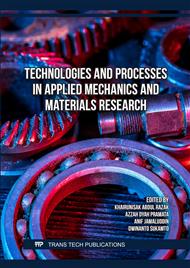[1]
G. Schnalzger, J. Maierhofer, W. Daves, R. Pippan, A. Hohenwarter, Fatigue crack growth of deformed pearlitic rail steels under multiaxial loading, Proc. Struc. Integ. 39 (2022) 313-326.
DOI: 10.1016/j.prostr.2022.03.101
Google Scholar
[2]
P. Ghosal, S.K. Paul, A. Raj, Influence of uniaxial and biaxial pre-straining on the high cycle fatigue performance of DP590 steel, Int. J. Fat. 151 (2021) 106369.
DOI: 10.1016/j.ijfatigue.2021.106369
Google Scholar
[3]
G.L.G. Gonzales, J.A.O. Gonzalez, J.L.F. Freire, Characterization of discontinuous crack closure behavior after the application of a single overload cycle, Theo. App. Frac. Mech. 114 (2021) 103028.
DOI: 10.1016/j.tafmec.2021.103028
Google Scholar
[4]
S. Gupta, P. Kucharczyk, S. Münstermann, R. Jayaganthan, Prestraining induced enhancement in the fatigue limit obtained by load increasing thermal method for metastable austenitic stainless steel, Steel Res. Intl. 89(4) (2018) 1700434.
DOI: 10.1002/srin.201700434
Google Scholar
[5]
Y. Kondo, T. Sudo, M. Kubota, Critical crack size that causes retardation of short fatigue crack by single overload, Fat. Frac. Eng. Mater. Struc. 32(10) (2009) 856-864.
DOI: 10.1111/j.1460-2695.2009.01393.x
Google Scholar
[6]
M. Badaruddin, H. Wardono, Zulhanif, H. Supriadi, M. Salimor, Experimental investigation of mechanical properties of cold-drawn AISI 1018 steel at high-temperature steady-state conditions, J. Mater. Res. Technol. 9(2) 2020 1893-1904.
DOI: 10.1016/j.jmrt.2019.12.021
Google Scholar
[7]
S. Bonk, J. Hoffmann, A. Hoffmann, J. Reiser, Cold rolled tungsten (W) plates and foils: Evolution of the tensile properties and their indication towards deformation mechanisms, Int. J. Refract. Met., 70 (2018) 124-133.
DOI: 10.1016/j.ijrmhm.2017.09.007
Google Scholar
[8]
ASTM E8-04, Standard Test Methods for Tension Testing of Metallic Materials [Metric], ASTM International (2004).
Google Scholar
[9]
ASTM E647-00, Standard Test Method for Measurement of Fatigue Crack Growth Rates, ASTM International (2000).
Google Scholar
[10]
T.L. Anderson, Fracture Mechanics: Fundamentals and Applications, fourth Ed., Taylor & Francis Group, Florida, 2017.
Google Scholar
[11]
M. Badaruddin, Sugiyanto, H. Wardono, Andoko, C.J. Wang, A.K. Rivai, Improvement of low-cycle fatigue resistance in AISI 4140 steel by annealing treatment, Int. J.Fat. 125 (2019) 406-417.
DOI: 10.1016/j.ijfatigue.2019.04.020
Google Scholar
[12]
R. Pippan, C. Zelger, E. Gach, C. Bichler, H. Weinhandl, On the mechanism of fatigue crack propagation in ductile metallic materials, Fatig. Fract. Eng. Mater. Struct., 34 (2010) 1-16.
DOI: 10.1111/j.1460-2695.2010.01484.x
Google Scholar
[13]
R. Ritchie, Mechanisms of fatigue-crack propagation in ductile and brittle solids. Int. J. Frac. 100 (1999) 55-83.
Google Scholar
[14]
S. Pillmeier, S. Žák, R. Pippan, A. Hohenwarter, Influence of cold rolling on the fatigue crack growth behavior of tungsten, Mater. Sci. Eng. A, 805 (2021) 140791.
DOI: 10.1016/j.msea.2021.140791
Google Scholar



